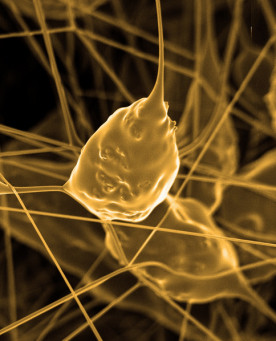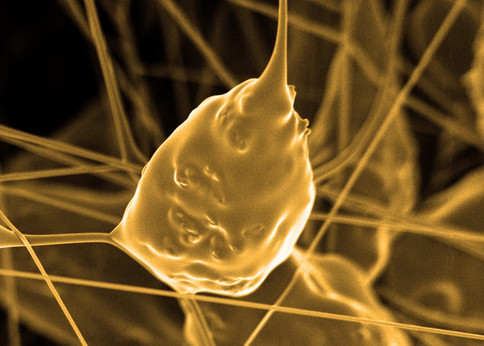The ability to short-circuit debilitating tremors in disease states with implantable stimulators is nothing short of remarkable. The same can be said for cochlear prosthetics which restore hearing, and more recently, retinal implants which give some rudimentary light-sensing capability to the blind. The logical extension of these sensorimotor restorative devices converges upon something a bit more extravagant—a purely cognitive implant—namely, the memory prosthetic. At the present time, there is only one researcher that has consistently demonstrated command of the technologies which would make such a device possible. Ted Berger, and his group from the University of Southern California, have recently extended their initial efforts to develop hippocampal memory devices in mice, to create full frontal cortex implants for primates. Berger published the initial results of these studies last September, in the Journal of Neural Engineering.
This June, he will be a featured speaker at the Global Futures 2045 International Congress in New York, which will spot several visionaries in neuroscience and AI. Before he runs away with the show, it important to take a closer look at the exact methods he is using, and also the assumptions about possible neural codes upon which they are built.
Efforts to restore memory loss due to Alzheimer’s disease have led to implantation of pacemaker-like stimulators in the fornix of patients. The fornix is the major output tract of the hippocampus, which is in turn just one among several components that must be counted among mammalian memory systems. In primates, the relative expansion of cortical structures, and hence their importance, has led Berger to develop a device which could work within this structure. The general strategy is to “decode” neuron activity in the superficial layers of the cortex, which presumably make essential functional connections to the deeper layer neurons, and stimulate those deeper neurons in a way that mimics how they would normally respond to superficial layer input in the healthy state. While that scheme certainly does not capture all the essential behavior of a given region of cortex, it is as good a place to start as any. The deep layer neurons are the ones that project out of the cortex to parts beyond. Their activity therefore represents, at least in theory, a summary of what is going on within that particular region. The approach has been to simultaneously record the activity of both the upper and lower layer neurons to build up a data set of their activity. Mathematical methods are then used to “decode” not only the activity of the upper layers, but also represent the responses of the deeper layer neurons to that activity. These decoding algorithms come from a field of mathematics known as nonlinear systems analysis. They were originally developed, or at least refined, during the Cold War era to track and target incoming missiles by extracting signals from noisy radar data. For the above mentioned prosthesis for the blind, these methods were simplified so that they could be used in a more practical way to represent the activity of a large group of cells in the retina. Berger’s collaborator at USC, Vasilis Marmarelis, is a pioneer in the application of these kinds of signal processing techniques to biological systems. When it comes to implementing these methods compactly in silicon VLSI chips, USC has also proven to be a place of ample resource for Berger.
Although these signal processing techniques have been called “decoding” algorithms, in actuality, they do not represent any kind of a neural code. They basically treat the system they are modeling as a “black box’ composed only of inputs and outputs. They do not attempt to include any of the underlying physiology of the neurons. The idea of the “neural code” itself is a bit of a misnomer. Berger begins with assumption that the spikes of neurons accurately reflect either sensory input, motor output, or something in between. Depending on the function of the particular cell, spikes assume contextual meaning external to the neurons themselves, and can therefore be cast as the medium of memory. In reality, spikes also reflect a lot about what is going on inside each neuron—they are the energetic end result of the activity inside the cell. In addition to integrating inputs from each its of neighbors, the output of neurons in the form of spikes bears testimony to the efforts of thousands of mitochondria in the cell competing for every molecule of oxygen and glucose metabolite in their domain. Without that energy, there are no spikes. Neurons do their best to keep things running smoothly, but much of the flexibility and responsiveness comes from this sensitivity to conditions inside and outside the cell. Any attempt to describe a code for a neuron needs to account for the fact that the cell that is doing the coding is a different animal from moment to moment. Replacing the function of a small patch of cortex is a good start. It may however, be a bit premature to call such a device an actual memory implant. Berger plans to condense all the hardware required to emulate, and stimulate, neurons into a small package that can fit inside the skull, free of any external tethers. He is also looking ahead to work with surgeons who have already implanted hardware in the hippocampus of patients with epilepsy, and apply his techniques there. Thus far, most of the experimental studies have focused on restoring some kind of memory ability to animals that have been challenged with a drug that reduces performance. For the monkey experiments, cocaine was the agent given to degrade cortical processing. Using cocaine to proxy an effect you hope to restore by localized and layer-specific cortical simulation is obviously not a perfect experiment. Unambiguously measuring the restoration of performance in a specific task for repetitively trained animals is quite a challenge in-and-of itself. Berger and his collaborator, Sam Deadwyler, demonstrated that their device could be used to bring the performance of cocaine intoxicated monkeys in line with normal performance in a delayed matching memory test. Another interpretation of the experiments might just as well be that the device might also make a handy cocaine antidote. Restoring performance is one thing, but augmenting normal performance to a higher level would be a far greater trick.
Story Source:
The above story is reprinted from materials provided by Medicalxpress.






